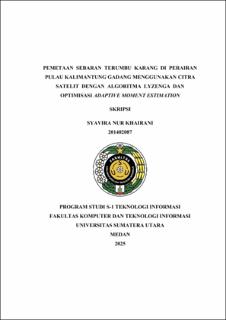Pemetaan Sebaran Terumbu Karang di Perairan Pulau Kalimantung Gadang Menggunakan Citra Satelit dengan Algoritma Lyzenga dan Optimisasi Adaptive Moment Estimation
Mapping The Distribution of Coral Reefs in Waters Kalimantung Gadang Island Uses Satellite Imagery with Lyzenga Algorithm and Adaptive Moment Estimation Optimization

Date
2025Author
Khairani, Syavira Nur
Advisor(s)
Arisandi, Dedy
Nasution, Umaya Ramadhani Putri
Metadata
Show full item recordAbstract
Kalimantung Gadang Island, located in Central Tapanuli Regency, boasts a rich and
diverse coral reef ecosystem. However, this ecosystem is under pressure due to various
human activities, such as pollution and the use of dynamite for fishing, which threaten
the sustainability of coral reefs in the area. The use of satellite imagery is one of the
innovative approaches to map the distribution and condition of coral reefs effectively.
With its wide range, high resolution, and integration capabilities with technology,
satellite imagery provides an opportunity to conduct in-depth analysis that supports
ecosystem conservation efforts. The research methods used are the Lyzenga algorithm,
Adaptive Moment Estimation optimization, and the Support Vector Machine model that
can overcome spectral variations in satellite image data. The data used is Sentinel-2A
satellite imagery which includes Band 1, Band 2, Band 3, Band 4, and Band 8. The
dataset used in this study includes 212 multipoints. This data is then divided into 70%
train data, 20% test data, and 10% validation data. The Support Vector Machine model
is trained and evaluated to classify aquatic areas: sand, coral reefs, vegetation, and the
sea. The Support Vector Machine model has an overall accuracy of 92%, according to
the final results.
Collections
- Undergraduate Theses [873]
